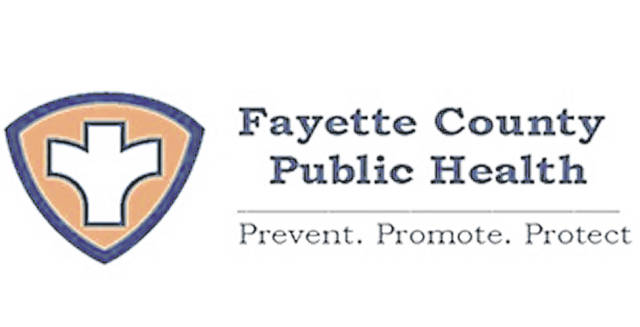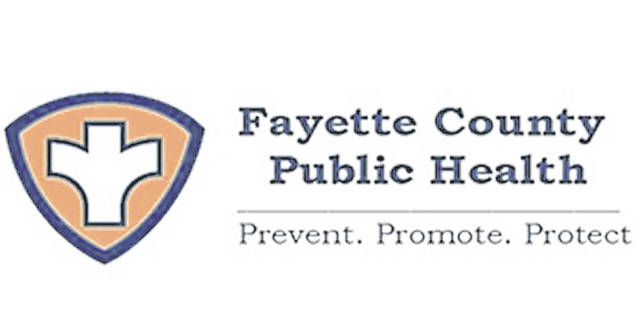

The level of community transmission of COVID-19 has increased to high for the county, according to Fayette County Public Health (FCPH), with 55 new cases reported over a 14-day period along with four new hospitalizations in the past week.
The 14-day period for the results ending Aug. 11 is 198.2 per 100,000 people. The county positivity rate for the 14-day period ending July 27 is 8.6%, up from 5.8% during the previous period.
Over 10% of Fayette County’s population has been reported as a positive case of COVID-19. There have been a total of 2,954 cases reported in Fayette County (2,337 confirmed, 617 probable) since the pandemic began.
With the four individuals hospitalized in the past week, the total number of hospitalizations is now at 242. There have been a total of 50 deaths, and 2,826 individuals are presumed recovered.
Vaccination reduces hospitalization and deaths from COVID-19, according to FCPH.
The Ohio Department of Health released a new dashboard with information about vaccine breakthrough hospitalizations and deaths. Since Jan. 1, 2021, there have been 19,028 hospitalizations for COVID-19 of individuals who were not fully vaccinated, as compared to 362 hospitalizations for fully vaccinated individuals.
There have been 6,910 deaths of individuals who were not fully vaccinated, and 67 deaths of individuals who were fully vaccinated. The dashboard can be found at www.coronavirus.ohio.gov/wps/portal/gov/covid-19/dashboards/covid-19-vaccine/breakthrough-dashboard.
Public Health recommendations:
—Get vaccinated. Vaccination reduces hospitalizations and deaths, and it also helps reduce the spread of virus in communities.
—Wear a mask. In areas with substantial and high transmission, CDC recommends that everyone (including fully vaccinated individuals) wear a mask in public indoor settings to help prevent the spread of the Delta variant and protect others.
Weekly Vaccination Provider Update
Fayette County Public Health (FCPH) — Clinics at FCPH are by appointment only. Schedule an appointment by calling 740-335-5910 or visiting faycohd.org. Moderna (18+): Aug. 26 from 9 a.m. to 2 p.m. Pfizer (12+): Aug. 16 from 8:30 a.m. to 11:30 a.m. and Aug. 24 from 1-6 p.m.
HealthSource of Ohio – Visit www.healthsourceofohio or call (740) 335-8490 to request an appointment.
Kroger – Visit kroger.com/ohiocovidvaccine or call the Kroger COVID-19 vaccine helpline at 866-211-5320.
Walgreens — Schedule through walgreens.com/schedulevaccine. The portal opens up each Saturday for Monday-Saturday appointments.
Walmart — Walmart is scheduling eligible individuals by appointment only dependent on vaccine availability. To schedule an appointment, visit walmart.com/covidvaccine.
Transportation — The Fayette County Transportation Program will transport anyone in Fayette County who needs to get their vaccine appointment, as long as they have a confirmed appointment scheduled. Anyone who needs transportation is asked to call 740-335-9628 to schedule as soon as they have an appointment time for the vaccine.
The local vaccination provider list is updated and shared weekly as a courtesy, and availability can change from day to day. Please contact the provider directly to determine which vaccine is being administered. Providers can also be searched for by visiting gettheshot.coronavirus.ohio.gov.
Please note: eligible individuals can receive a vaccine from any provider of their choice. The vaccine is offered at no cost at all locations. Vaccine providers can bill a patient’s insurance for a fee to administer the vaccine but will not be able to charge the patient.
Pfizer is the only vaccine that has been authorized for 12 years and older. Parental or legal guardian permission is required for minors (12-17 years old).
Moderna and Pfizer each require two doses. Full protection is not gained until two weeks after the second dose of vaccine.
In addition to this list, private healthcare providers may be offering the vaccine. Contact a healthcare provider for details.
Stay updated by following Fayette County Public Health on Facebook, facebook.com/faycohd, or visiting the FCPH website at www.faycohd.org.
States that had grip on COVID now seeing a crush of cases
The COVID-19 surge that is sending hospitalizations to all-time highs in parts of the South is also clobbering states like Hawaii and Oregon that were once seen as pandemic success stories.
After months in which they kept cases and hospitalizations at manageable levels, they are watching progress slip away as record numbers of patients overwhelm bone-tired health care workers.
Oregon — like Florida, Arkansas, Mississippi and Louisiana in recent days — has more people in the hospital with COVID-19 than at any other point in the pandemic. Hawaii is about to reach that mark, too.
This, despite both states having vaccination levels higher than the national average as of last week. Arkansas and Louisiana were significantly below average, while Florida was about even. Mississippi, meanwhile, ranks at the very bottom for vaccination rates.
“It’s heartbreaking. People are exhausted. You can see it in their eyes,” said Dr. Jason Kuhl, chief medical officer at Oregon’s Providence Medford Medical Center, where patients are left on gurneys in hallways, their monitoring machines beeping away. Others needing treatment for cancer or heart disease are being turned away.
In other developments, the Food and Drug Administration is expected to authorize a third COVID-19 shot for certain people with weakened immune systems, such as cancer patients and organ transplant recipients, to give them an extra dose of protection.
The U.S. is seeing the virus storming back, driven by a combination of the highly contagious delta variant and lagging vaccination rates, especially in the South and other rural and conservative parts of the country.
New cases nationwide are averaging about 123,000 per day, a level last seen in early February, and deaths are running at over 500 a day, turning the clock back to May.
For the most part during the pandemic, Hawaii enjoyed one of the lowest infection and death rates in the nation. In recent days, though, it reported record highs of more than 600 new virus cases daily.
On its worst day in 2020, Hawaii had 291 patients hospitalized with the coronavirus. Officials expect to hit 300 by the end of this week.
Despite the promising demand for COVID-19 shots early on, it took three weeks — much longer than expected — to get from 50% to 60% of the vaccine-eligible population fully vaccinated. Vaccinations have since plateaued. Nationally, the rate is about 59%.
The biggest hospital on Hawaii’s Big Island is feeling the pressure. Out of 128 acute beds, 116 were taken Wednesday at Hilo Medical Center, and the hospital’s 11 intensive care unit beds are almost always full these days, spokeswoman Elena Cabatu said.
“If someone out there has a heart attack or a sepsis or gets into a bad accident that requires intensive care, we will have to hold that person in the emergency department,” Cabatu said.
“I’m surprised we landed here,” she lamented. “The hope during the mass vax clinics was just so high.”
Hilton Raethel, president and CEO of the Healthcare Association of Hawaii, disputed any notion that the rebound in tourism in Hawaii is largely to blame.
“The tourists have been a source for infection, but they’ve never been the predominant source of infection,” Raethel said. “There’s a lot more concern about people from Hawaii, residents who go to the South, go to Vegas, to other places, and they come back and spread it.”
In Oregon, a record number of COVID-19 hospitalizations — 670 — was reported for a third straight day Thursday. ICU beds across the state remain about 90% full with COVID-19 patients occupying 177 of them, the Oregon Health Authority said. The previous peak of 622 hospitalizations came during a November surge.
“Our doctors and nurses are exhausted and rightfully frustrated because this crisis is avoidable. It is like watching a train wreck coming and knowing that there’s an opportunity to switch tracks, yet we feel helpless while we watch unnecessary loss of life,” said David Zonies, associate chief medical officer at Portland’s Oregon Health & Science University.
Public health officials in the southern part of the state said they fear the situation will only get worse as the delta variant spreads through a region where fewer than half the residents have been fully vaccinated.
“I’m fearful that the darkest days of this pandemic may still be ahead of us,” said Chris Pizzi, CEO of Providence Medical Center in Medford.
In a renewed effort to stop the spread, Gov. Kate Brown announced this week that nearly everyone will have to wear masks again in indoor public spaces, regardless of their vaccination status.
Throughout the pandemic, health officials have described Oregon as a success story, largely because of its tight restrictions, which were lifted at the end of June.
California, which is below the national vaccination rate, is also seeing alarming spikes in hospitalized COVID-19 patients. Los Angeles County, the nation’s largest county, faced 1,573 hospitalizations as of Wednesday — the highest since the end of February. The city of Los Angeles is working out a possible vaccine requirement to enter indoor spaces.
Meanwhile, White House coronavirus coordinator Jeff Zients said more people are getting vaccinated in states with the highest infection rates, including Arkansas, Louisiana, Alabama and Mississippi.
“We’re getting more shots in the arms in the places that need them in the most. That’s what it’s going to take to end this pandemic,” he said.
Mississippi broke its single-day records of COVID-19 hospitalizations, intensive-care use and new coronavirus cases. The state Health Department said 1,490 people were hospitalized Wednesday and 388 were in the ICU because of COVID-19. It also confirmed 4,412 new cases. The state health officer, Dr. Thomas Dobbs, said a majority of the cases are in the unvaccinated.
In Florida, where Republican Gov. Ron DeSantis has steadfastly blocked mandatory mask-wearing, some emergency rooms are so overcrowded that doctors are sending patients home with oxygen and small, portable oxygen-monitoring devices to free up beds for sicker patients.


